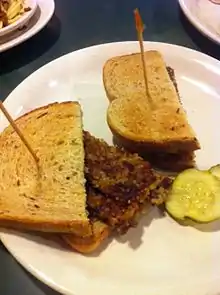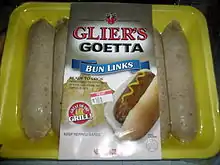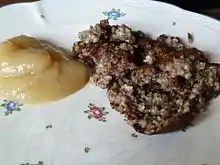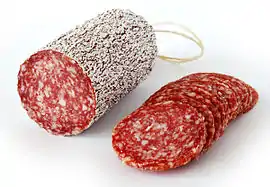Goetta
Goetta (/ˈɡɛtə/)[1] is a meat-and-grain sausage or mash[2] of German inspiration that is popular in Metro Cincinnati. It is primarily composed of ground meat (pork, or pork and beef), pin-head oats and spices.[3] It was originally a dish meant to stretch out servings of meat over several meals to conserve money,[4] and is a similar dish to scrapple and livermush, both also developed by German immigrants.[5]
 Goetta sandwich | |||||||
| Type | Sausage or Mush | ||||||
|---|---|---|---|---|---|---|---|
| Course | Breakfast | ||||||
| Place of origin | Cincinnati metropolitan area | ||||||
| Associated national cuisine | American | ||||||
| Serving temperature | Hot | ||||||
| Main ingredients | Pinhead oats; pork and/or beef | ||||||
| Ingredients generally used | Onion, spices, herbs | ||||||
| 180 kcal (754 kJ) | |||||||
| |||||||
| Similar dishes | Knipp, scrapple | ||||||
Origins
The dish probably originated with German settlers from the northwestern regions of Oldenburg, Hannover, and Westphalia who emigrated to the Cincinnati area in the 19th century.[1][6]
The first commercial producer was Sander Packing.[7]
Composition


While goetta comes in a variety of forms, all goetta is based around ground meat combined with pin-head oats, the "traditional Low German cook's way of stretching a minimum amount of meat to feed a maximum number of people."[8]:244 Usually goetta is made from pork, but occasionally contains equal parts pork and beef. Goetta is typically flavored with bay leaves, rosemary, salt, pepper, and thyme. It contains onions and sometimes other vegetables.[1] The USDA standards for goetta require that it contain no less than 50% meat.[9]
While similar to Pennsylvanian scrapple and North Carolinian livermush in that it is a dish created by German immigrants and uses a grain product for the purpose of stretching out pork to feed more people, scrapple is made with cornmeal and livermush with either cornmeal or rice rather than the pinhead oats used in goetta.[10][11]
Preparation and serving
Goetta is made with meat, oats, broth, spices, often onions, and occasionally other vegetables, simmered until thick, poured into loaf pans, and chilled or allowed to cool completely so that the loaves become firm enough to slice. It is then cut into slices and fried, often in butter.[8]:244
Traditionally goetta is served as a breakfast food, but it is also put into sandwiches and used as a topping for burgers and pizza.[12]
Commercial distribution
A number of commercial distributors produce and sell goetta in the parts of Ohio, Kentucky, and Indiana near Cincinnati. Glier's Goetta, established in 1946, produces more than 1,000,000 lb (450 metric tons) annually, around 99 percent of which is consumed locally in Greater Cincinnati.[6] Queen City Sausage is the next largest producer, while multiple small and artisanal producers also make goetta in and around Cincinnati.[1]
Goettafest
"Glier's Goettafest" is an annual culinary festival held in August on the Ohio River waterfront near Newport, Kentucky's Newport on the Levee. The festival celebrates both the dish and Greater Cincinnati's German American heritage. While the main focus of the festival is goetta served in many different ways, it also typically includes music, dancing, and other public entertainment.[13] In 2019 it expanded to two consecutive weekends.[14]
Misconception

Glier's markets goetta as the "German Breakfast Sausage,"[15] which may create the impression that it is something commonly eaten for breakfast in Germany. Cincinnati food expert Dan Woellert says, "Will you find something on a menu called goetta in a Westphalian gasthaus? The answer is no," but that grützwurst and knipp are similar "meat gruels".[16]
See also
References
- RAPOSO, JACQUELINE. "Goetta: The Cincinnati German-American Breakfast Staple". seriouseats.com. Retrieved 18 April 2015.
- "Seven Innovative Takes on Cincinnati Goetta to Change Your Mind About the Meat". City Beat. 7 Aug 2018. Retrieved 27 October 2018.
- Smith, Steve; et al. (2007). "Are You Ready For Cincinnati?". Cincinnati USA City Guide. Cincinnati Magazine. p. 144. Retrieved 2013-05-06.
- Larson, Sarah (2015-08-28). "HOW TO MAKE CINCINNATI'S WEIRD, TASTY BREAKFAST MEAT, GOETTA". Escoffier Online. Retrieved 27 October 2018.
- Cohen, Jason (September 2015). "Everything You Need to Know About Scrapple". Eater. Retrieved 27 October 2018.
- "Glier's History - Glier's Goetta". goetta.com. Archived from the original on 2 April 2015. Retrieved 18 April 2015.
- Furbee, Bill (July 29, 2019). "'Cincinnati Goetta: A Delectable History' is a New Book About This Classic Cincinnati Dish". CityBeat Cincinnati. Retrieved July 31, 2019.
- Stern, Jane and Michael (2009). 500 Things to Eat Before it's Too Late:and the Very Best Places to Eat Them. New York: Houghton Mifflin Harcourt. ISBN 978-0-547-05907-5.
- "Food Standards and Labelling Book" (PDF). US Dept of Agriculture. Retrieved 27 October 2018.
- Dewan, James (4 September 2018). "Move over, livermush: Goetta may be even better". Charlotte Observer. Retrieved 27 October 2018.
- Woellert, Dann (April 16, 2013). The Authentic History of Cincinnati Chili. The History Press. p. 10. ISBN 9781609499921. Retrieved 2013-05-18.
- Rife, Katie. "ACQUIRED TASTES Goetta, Cincinnati's second most-famous food, is a sausage for the working man". The Takeout. Retrieved 27 October 2018.
- "Glier's GoettaFest". Goettafest.com. Retrieved 2015-04-23.
- Brookbank, Saran. "Craving more Goettafest? Festival expands to 8 days over 2 weekends". Cincinnati Enquirer. Retrieved 20 April 2019.
- "Glier's Goetta". goetta.com. Retrieved 18 April 2015.
- Woellert, Dan (2014-08-05). "A Mispronounced German Delicacy". Retrieved 27 October 2018.
- Dann Woellert (22 July 2019). Cincinnati Goetta: A Delectable History. Arcadia Publishing Incorporated. ISBN 978-1-4396-6745-3.
